So is the 13" Retina MacBook Pro just a smaller version of the 15" Retina MacBook Pro? Not exactly.
- The 13" Retina MacBook Pro comes only with a Dual-Core i5 or Dual-Core i7 while the 15" Retina MacBook Pro comes with a Quad-Core i7.
- The 13" is limited to an integrated Intel HD Graphics 4000 GPU with "borrowed" memory while the 15" comes with a discrete NVIDIA GeForce GT 650M with dedicated memory
- The 13" RMBP is limited a max of 8G of RAM. The 15" RMBP can be ordered with up to 16G.
We decided to conduct a shootout between an example of each to illustrate the performance gap which may be critical for you if you are running professional apps.
GRAPH LEGEND
13" MBA dual i7 = 2012 13" MBA dual-core i7 2.0GHz with Intel HD 4000
13" RMBP dual i5 = 2012 13" Retina MBP dual-core i5 2.5GHz with Intel HD 4000
15" RMBP quad i7 = 2012 15" Retinal MBP quad-core i7 2.7GHz with GeForce GT 650M
The MBA and 13" RMBP had 8G of RAM. The 15" RMBP had 16G.
Maxon's Cinebench 11 cross-platform benchmark uses code from Cinema 4D to show how fast multi-core CPUs can render a 3D model. Rather than time in seconds, it gives a speed rating. The 15" Retina MacBook Pro flexes its quad-core muscle here. (HIGHER number rating is FASTER)
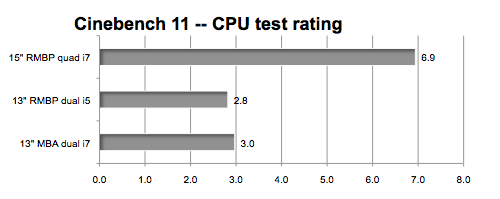
Adobe Photoshop CS6 now uses OpenCL acceleration on certain filters like the Iris Blur. The Intel HD 4000 in the 13" Retina MacBook Pro does not support that acceleration so it has to render the filter with the dual-core CPU. (LOWER number in seconds is FASTER)
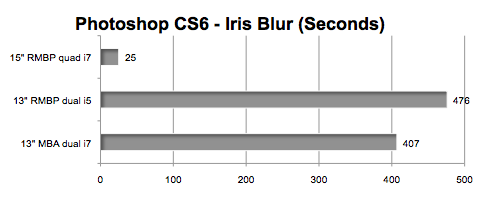
A Photoshop CS6 filter that's more CPU intensive is "Reduce Noise." (LOWER number in seconds is FASTER)

Apple Final Cut Pro X leans on the GPU when rendering the Directional Blur effect on our sample of eight HD clips. (LOWER number in seconds is FASTER)
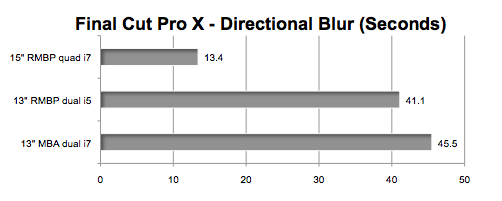
Apple Aperture 3 was used to show how long it takes to convert 50 RAW images to original size JPEG and write them to the internal SSD. (LOWER number in seconds is FASTER)
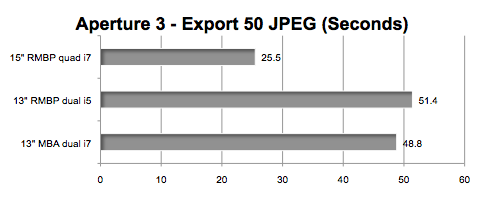
Noise Ninja is a Plugin for Aperture for removing noise and grain from digital photographs. It is a must-have tool for anyone shooting in low-light or fast-action situations. We applied it to 50 RAW images of a Soccer match. (LOWER number in seconds is FASTER)
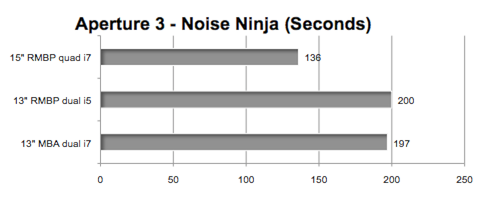
Apple Motion 5 attempts to playback a project while rendering on the fly. The limited memory and weak GPU of the 13" Retina MacBook Pro is apparent here. The 15" Retina MacBook Pro is able to maintain the "real time" frame rate of 29.9 FPS. Also, when we did a RAM preview, the 13" Retina MacBook Pro could only render in memory 311 of the 600 frames. (HIGHER number in Frames per Second is FASTER)

Feral Interactive's Dirt 2 has a built-in benchmark. We used high quality settings to see stress the GPU in each laptop. (HIGHER number in Frames per Second is FASTER)
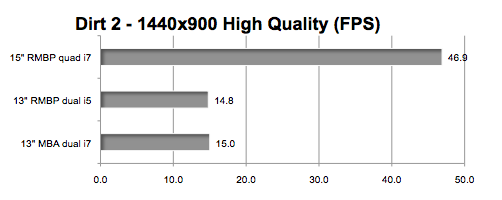
Unigine Heaven 3 is a cross-platform benchmark that uses 26 flyby/walkthrough scenes to measure DirectX or OpenGL performance. (HIGHER number in Frames per Second is FASTER)
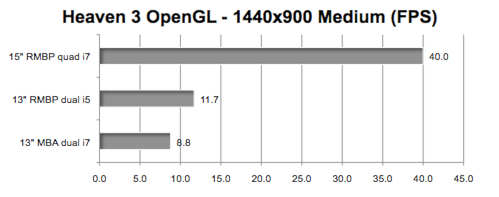
INSIGHTS
The Quad-Core 15" Retina MacBook Pro is much faster than the Dual-Core 13" Retina MacBook Pro when performing CPU intensive operations. And its discrete GeForce GT 650M GPU blows away the 13" Retina MacBook Pro's integrated Intel HD 4000 GPU.
We included in the 2012 MacBook Air with 2.0GHz Dual-Core i7 CPU and Intel HD 4000 GPU. What's the point? If you want a light weight Apple laptop with a 13" screen and don't require a Retina display, you get just as good performance with the Core i7 MacBook Air as you do with the 13" Retina MacBook Pro Core i5 and pay $300 less on the similarly configured model (8G RAM, 256G SSD) --- and save a half a pound on weight. Then again, that Retina display is awesome and the 13" Retina MacBook Pro comes with two Thunderbolt ports instead of one.
BOTTOM LINE
The 13" Retina MacBook Pro is for consumers who want an "insanely great" small screen but don't have heavy computing requirements. The 15" Retina MacBook Pro is for professionals who run demanding pro apps.
Thoughts? Contact
Also, you can follow him on Twitter @barefeats